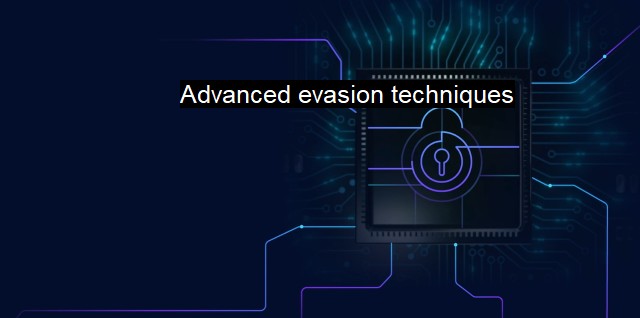What are Advanced evasion techniques?
Disrupting Detection: Understanding Advanced Evasion Techniques and Their Devastating Impact on Cybersecurity"
Advanced evasion techniques, often abbreviated as AETs, are a category of methods that cybercriminals utilize to mask their maleficent activities on a network. Emerged these techniques demonstrate a unique level of sophistication and bypassing ability, enabling intrusion into a target system practically unnoticed.The context of advanced evasion techniques primarily sits within the wider scope of cybersecurity and in harmony with the counter measures such as antivirus and Intrusion Prevention Systems (IPS). It catapults the age-old cyber warfare to new levels by cunningly executing network-based attacks while effortlessly evading detection by standard IPS and antivirus security systems.
To understand AETs, it is essential to know their origin. Their existence was revealed in 2010 by Stonesoft Corporation, acquired later by McAfee. According to the company's research, these powerful means of intrusion represented a category of cyber-threat never witnessed before. The main characteristic that deems evasion techniques advanced is their ability to dynamically change, disguising themselves in network traffic. This potent attribute complexifies the detection task and renders conventional network security tools and antivirus software inefficient.
Advanced evasion techniques pose a real and emerging threat due to their specific nature to exploit system vulnerabilities while remaining invisible. AETs can bypass the network's defenses, probing and then enabling an attack on any weak point, typically through crafted network packets that go undetected. Combining evasion methodologies on multiple levels like transport and application forms the essence of AET's stealth approach, helping attackers dodge security mechanisms.
For instance, an AET might modify standard protocol implementation subtly, trick IP packet fragmentation, or tamper with TCP segmentation processes. By doing so, it divides a conspicuous and malware-laden intrusion into innocuous-looking, standalone smaller units. Once inside the network, these segments harmoniously reassemble into their sinister form, far from the clutches of security systems.
Another unique feature of AETs is their unpredictability, as they exploit a vast assortment of over 800 evasion techniques in multiple combinations. With millions of permutations possible, predicting the characteristics of a potential AET uprising becomes a next-to-impossible task for conventional security apparatus. The implications are clear: relying on predefined signatures and patches have waned in the face of such multivariate and multidimensional threats. the rate at which new instances of AETs are being uncovered suggests a grim security prospect.
Addressing the challenge of AETs requires an intimate understanding of this elusive adversary. Incorporating advanced threat intelligence which focuses on behavioral analysis rather than relying on traditional signature-based security measures can prove effective. The adoption of machine learning algorithms which hold immense potential for proactive security management can also bolster overall defense mechanisms against AETs.
Next-gen firewalls representing a hybrid breed of IPS and traditional firewalls get heightened with Deep Packet Inspection (DPI) capabilities, aiding better detection of AETs. The close-knit integration of intrusion prevention systems and robust antivirus software with real-time evasion detection capabilities adds vigour to this defense framework.
Advanced evasion techniques are not a newfound threat, but their ingenuity and complexity intensify the challenges faced by security professionals and antivirus software alike. The stealthy and dynamic characteristics of AETs make them a formidable weapon in the cybercriminal’s arsenal. As the cybersecurity landscape persists in its evolution, so must defenses innovate continuously to guard against these covert and morphing threats.

Advanced evasion techniques FAQs
What are advanced evasion techniques in cybersecurity?
Advanced evasion techniques (AETs) are sophisticated methods used to bypass security measures in order to gain unauthorized access to a computer network or device. These techniques involve the manipulation of data, protocols, or network traffic in a way that allows the attacker to avoid detection by traditional security software.How do advanced evasion techniques work?
Advanced evasion techniques work by fragmenting and rearranging malicious code in such a way that it can slip past traditional security measures undetected. This is achieved through the use of specialized tools that can manipulate data, protocols, or network traffic to create a complex stream of data that can evade detection.What are some examples of advanced evasion techniques?
Some examples of advanced evasion techniques include IP fragmentation, protocol obfuscation, TCP evasion, and payload obfuscation. These techniques allow attackers to create a complex stream of data that can bypass traditional security measures such as firewalls and intrusion detection systems.How can organizations protect themselves from advanced evasion techniques?
Organizations can protect themselves from advanced evasion techniques by using advanced security measures such as next-generation firewalls, intrusion prevention systems, and network-based security analytics. These tools are specifically designed to detect and block AETs by analyzing network traffic and identifying patterns of suspicious behavior. It is also important for organizations to keep their security software up-to-date and regularly perform vulnerability assessments to identify potential weaknesses in their networks.| | A | | | B | | | C | | | D | | | E | | | F | | | G | | | H | | | I | | | J | | | K | | | L | | | M | |
| | N | | | O | | | P | | | Q | | | R | | | S | | | T | | | U | | | V | | | W | | | X | | | Y | | | Z | |
| | 1 | | | 2 | | | 3 | | | 4 | | | 7 | | | 8 | | |||||||